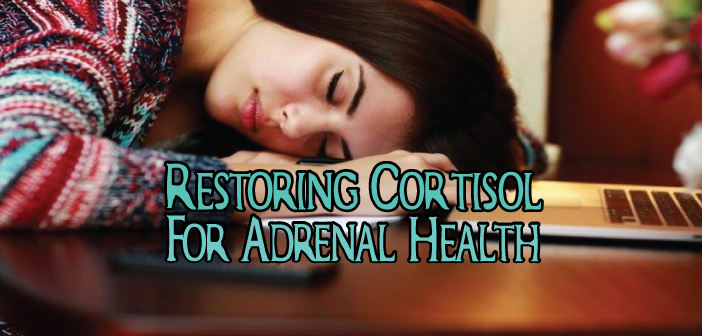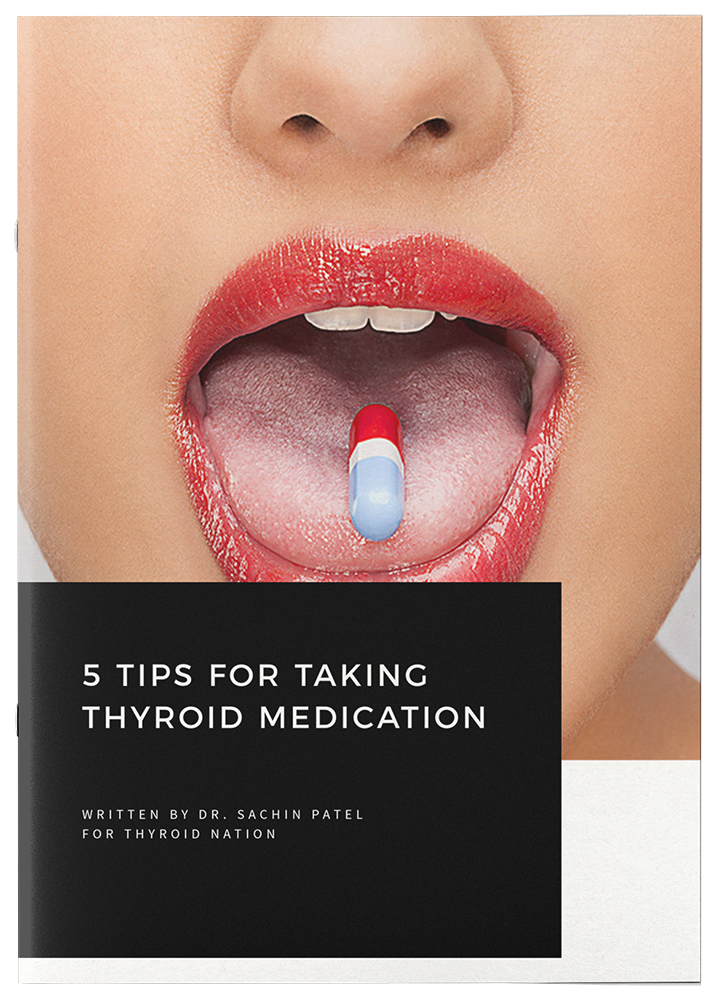
Elizabeth Millard, Guest Thyroid Nation
Cortisol — “The Stress Hormone”
This “stress hormone” is essential for energy and health, but when it’s out of balance, you are, too. Learn how to manage cortisol to keep inflammation, cravings, and belly fat at bay.
Cortisol has a bad reputation. Commonly known as the “stress hormone,” it’s produced, in part, by the adrenal glands when we’re under pressure and perceive a threat. The pituitary gland determines how much hormone the adrenals should release to help us fight or flee. This alarm system works beautifully — until it doesn’t. In today’s fast-paced culture, many of us are overworked, underrested, and under pressure from too many obligations, and the alarm never stops. It’s this state of chronic agitation that triggers cortisol function to run amok, contributing to a host of problems: insomnia, excess belly fat, anxiety, and extreme fatigue, to name just a few. It’s no wonder cortisol has gotten a lot of bad press in the health media. Yet without it we’re helpless. The hormone isn’t produced solely in response to stress; chronic stress just puts it into overdrive. Normal levels are critical for maintaining steady energy throughout the day. And cortisol orchestrates the performance of other key hormones, like estrogen, testosterone, and thyroid. Functional-medicine practitioner Sara Gottfried, MD, author of The Hormone Reset Diet, calls cortisol the “control system” for hormones. “It’s getting your blood pressure up only when it needs to be up,” she explains. “It raises your blood sugar only when you most need it. It modulates your immune system.” Optimally performing cortisol follows a pattern called the “cortisol curve.” In a healthy curve, cortisol is high in the morning and tapers off through the day and evening — like a slow-release energy pill that wears off just in time for bed. But when we’re chronically stressed, the body releases cortisol at all hours. The curve turns into a roller coaster, and excess cortisol causes us to develop a hair-trigger response to stress. This can lead to adrenal exhaustion. “High cortisol levels wreak havoc over time, deplete your happy brain chemicals like serotonin, rob your sleep, and make you store fat, especially in your belly,” says Gottfried. “High cortisol is likewise linked to depression and food addiction.” Imbalances can also lead to inflammation and thyroid issues. But Gottfried emphasizes that these problems can be fixed. And though restoring a smooth cortisol curve takes a little time and effort, the results are well worth it.
Cortisol Gone Rogue
In an ideal world, cortisol is highest in the morning, helping us stay focused during the day. It gradually tapers off through the afternoon and evening. But if your energy starts to run low during familiar activities, says Filomena Trindade, MD, of the Institute for Functional Medicine, it could be a warning that your cortisol pattern is disrupted. Catching more colds or having a shorter emotional fuse are other early signs. A saliva test at a lab can confirm if this is the problem. “You can’t keep withdrawing from your adrenal bank account without putting more funds in, with sleep and other healthy-lifestyle habits,” she says. “You’ll go bankrupt.” Here are some of the common patterns malfunctioning cortisol levels tend to follow. All of them can overlap, but most often they occur in progression. After a prolonged period of producing extra cortisol, the adrenals eventually get fatigued and quit making the hormone.
High Early-morning Cortisol Levels
A healthy curve begins with cortisol levels highest in the morning, but not hours before dawn. Cortisol levels are normally lowest around 3 a.m., then begin to rise, peaking around 8 a.m. If you routinely wake up hours before dawn in a state of anxiety, your cortisol is overachieving and spiking too early. This could be happening if:
- You rarely sleep through the night.
- Your mind is racing the moment you wake up.
- You’re edgy and confrontational in the mornings.
- Your energy crashes and burns sometime around midmorning.

High Cortisol Levels Throughout The Day
Cortisol spikes in response to stressors like work deadlines, environmental pollution, and inadequate sleep. Ongoing high levels of cortisol can be caused by too much coffee, a lack of carbs throughout the day, or an intensive focus on schedules. If cortisol levels stay elevated, you’re wired but your adrenals are getting tired. It feels like:
- You’re constantly behind schedule and racing to catch up.
- You’re exhausted and hyper at the same time.
- People comment on how fast you talk.
- You’re easily irritated and feel little enthusiasm for anything.

High Evening Cortisol Levels
If you often find yourself in heated political arguments online at 9 p.m., or if you do heavy training at the gym in the evenings, it’s likely that your cortisol levels are skyrocketing at night — right when you want them to be coming down. Some common indications of high evening cortisol levels are:
- Falling asleep is nearly impossible and can take hours.
- You worry in the evenings or feel especially argumentative.
- You distract yourself by spending a lot of time online, watching TV, or working out at night — which can lead to self-defeating cycle of even higher evening cortisol.

Low Cortisol Levels Throughout The Day
After cortisol has been elevated for an extended period, it can drop off completely. When it does, you feel flatlined. This usually signals adrenal exhaustion, when the overworked glands have shut down. Causes include prolonged and intense stress, sustained periods of inadequate sleep, and a general lack of physical and mental rest. Some indications of low cortisol are:
- You’re dragging through each day, even after plenty of sleep.
- It takes high-octane coffee or intense exercise to pull you up — but it doesn’t last.
- You fall asleep everywhere, including work meetings.
How To Restore Your Cortisol Balance
You might now be thinking of cortisol as a frenemy, especially if you’ve experienced any of the problem patterns described on the previous page. Here’s the good news: There are concrete ways to befriend the hormone and -normalize your levels, says Gottfried — none of which requires a trip to the pharmacy. “When it comes to controlling cortisol, basic lifestyle and supplement strategies are powerfully effective for most people,” she says. Read on for tactics that can help you get your cortisol levels in check.
 Cycle Carbs
Cycle Carbs
A low-carb diet can support weight loss, but it’s not ideal for those with disrupted cortisol. In a 2014 clinical trial, subjects with cortisol issues were able to “reset” their curves by eating low-carb breakfasts, moderate amounts of healthy carbs in the afternoon, and higher amounts of healthy carbs (think sweet potatoes, not pasta or bread) in the evening. Endocrinologist Alan Christianson, NMD, author of The Adrenal Reset Diet, directed the trial. He now prescribes this carb-cycling protocol to his patients who are dealing with any type of cortisol disruption. “Imagine a seesaw: Higher-carb meals drop the cortisol, and lower-carb meals allow the cortisol to stay higher,” Christianson explains. This is because carbs elevate blood sugar, so the pancreas makes more insulin to manage that increase. Insulin decreases cortisol output. As blood sugar goes up, cortisol gets pushed down. Avoiding carbs altogether can cause cortisol to stay elevated when you want it to come down, Christianson adds. “When you’re too low on carbs, you raise cortisol because the muscles are being pulled apart for that glucose,” Christianson says. “In turn, that elevates cortisol even more, and that can really be a problem in the evening.”
Supplement Your Nutrition
There’s no single supplement that can reset your cortisol pattern, but Gottfried suggests stocking up on three essential nutrients: omega-3 fatty acids and vitamins C and B5 (pantothenic acid). In a 2010 study published in the Journal of the International Society of Sports Nutrition, healthy subjects who took 2,400 mg of fish oil daily for six weeks lowered morning cortisol levels and showed leaner body mass. Because vitamin B5 appears to reduce the hypersecretion of cortisol, Gottfried recommends it as a “low-risk treatment” for those with chronic stress. (Go with a good B-complex to ensure you’re getting the full complement of these stress-relieving nutrients.) She also advises taking a modest amount of vitamin C (no more than 1,000 mg per day), which has been shown to lower cortisol in surgical patients.
Stay Hydrated
We’re more likely to become dehydrated under stress — and not only because we might neglect drinking water. Feeling anxious raises our heart rate and triggers faster, heavier breathing, both of which lead to fluid loss. Even if we’re drinking plenty of water, we can still get dehydrated when stressed, says Trindade, because we urinate more frequently. “The water may be going through you instead of into your cells,” she says. If you notice that you urinate within minutes of drinking, it can be a sign that you’re not getting the benefits of hydration. When that’s the case, Trindade suggests adding some trace minerals or amino acids to your water to ensure you receive its benefits. Maintaining optimal levels of essential fatty acids is also helpful.
Practice Relaxing
Your adrenal glands don’t care if stress is mental or physical. Their job is to protect you when you feel endangered, and they’ll pump out cortisol whenever you feel agitated and threatened — at least until they burn out. But when you learn to calm the mind and regain a sense of control, the sympathetic nervous system stays quiet. Trindade emphasizes the value of a spiritual practice (however you define that) as an antidote to a constant sense of alarm. It could be praying, doing yoga, walking through the woods, or taking five minutes at lunch to quietly listen to the sounds around you. “Find a practice that’s easy to do and makes you feel connected and centered,” she recommends. Gottfried concurs: “Contemplative practice is nonnegotiable.” “This is especially true if you’re struggling with your weight,” she adds, citing a 2011 study from the University of California, San Francisco, that found overweight and obese women lost fat on their midsections after participating in a mindfulness program for four months. “That makes sense, because your belly fat contains four times the cortisol receptors as fat elsewhere in the body.” Relaxation practices are beneficial any time of day, regardless of your present cortisol pattern, but they are especially helpful in the evenings to promote better sleep.
Time Your Workouts
We’ve been taught that intense exercise is a great way to de-stress, but Trindade says that isn’t necessarily so. “Taking a spin class at 8 p.m. can create a very different cortisol level than a restorative yoga class at that same time,” she says. “For many people, creating a cortisol spike in the evening is just not helpful.” Intense exercise raises cortisol levels, which is great if you’re looking for an extra energy boost in the morning or midafternoon. But an evening or nighttime workout is not so beneficial if it’s prompting insomnia or anxiety. This doesn’t mean you have to ditch your evening workout if that’s the only time you have. But recognize that a schedule shift could help you reset your cortisol. Observe how specific types of exercise make you feel, and whether they affect your sleep or energy levels. And if you have to temporarily switch that group cycling class for yoga in order to sleep, your adrenal glands will thank you.
Relieve Stress With Adaptogens
For thousands of years, practitioners of Traditional Chinese Medicine and Ayurveda have used adaptogenic herbs — ginseng, rhodiola, ashwagandha, eleuthero, and others — to relieve stress. “Adaptogens can be a good way for some people to bring their cortisol back to a healthy pattern,” says Trindade. “Some are very well-researched and can make a big difference, no matter what type of adrenal issues you’re dealing with.” Adaptogens not only reduce stress levels, but also help restore cortisol levels to their natural curve. These herbs support the adrenal and pituitary systems, helping them operate more efficiently. With those systems functioning properly, cortisol is more likely to be released when it should be, instead of spiking up and down. (For more, see “Ancient Healers: Adaptogens“.)
Get Some Sleep
Rest is key to restoring a healthy cortisol curve, so even when you still have a lot to get done, you’re not sleepy, or it’s your only time to really catch up on email, go to bed anyway. “Sleep is huge when it comes to cortisol, absolutely huge,” says Trindade. “We know that going from eight hours of sleep to six hours will cause big disruptions in cortisol patterns in less than two weeks.” What’s more, if you are eating healthy carbs with dinner, engaging in a little relaxation practice, and using adaptogens, you might find that falling into a deep, restorative sleep is suddenly much easier. “Think of sleep as an indicator of whether your efforts to reset your cortisol patterns are working,” says Trindade. (For more on sleep’s benefits, see “The Healing Power of Sleep“.)
Upgrading your sleep patterns will support other healthy lifestyle changes, too. Getting enough rest, for example, will make it easier to skip that second (or fourth) cup of coffee in the morning. It will keep you focused during a meditative practice and less likely to slip into a cat nap. That’s because cortisol and melatonin — the hormone that regulates sleep and wake cycles — work in tandem. When cortisol drops, melatonin takes over and makes you sleepy. When you’re asleep, relatively low levels of cortisol allow your cells to repair and heal. If cortisol levels stay elevated, your body can’t make those repairs and you wake up feeling fatigued.
When your cortisol curve is back on track, you’ll have the energy you need throughout the day and get the rest you deserve — without slogging through the wired-but-tired cycle. You’ll enjoy the pleasing feeling of skiing down a mountain rather than being jerked around on a roller coaster. And you and cortisol will be friends again, working together instead of dragging each other down. Source
About the Author
 Elizabeth Millard is a freelance writer and editor based in northern Minnesota. Her points of focus are health, wellness, fitness, and food. Experience includes feature articles, news writing, e-books, blog posts, brochures, webpages, and social media posts. She has written numerous pieces for Experience Life magazine. You can find more of her writing by clicking here.
Elizabeth Millard is a freelance writer and editor based in northern Minnesota. Her points of focus are health, wellness, fitness, and food. Experience includes feature articles, news writing, e-books, blog posts, brochures, webpages, and social media posts. She has written numerous pieces for Experience Life magazine. You can find more of her writing by clicking here.
PLEASE take a moment to ‘Like’ us on Facebook and follow us on Twitter and Pinterest. You can also listen to Tiffany and I on Thyroid Nation RADIO.







Very interesting article especialy having diabetis and unstable readings at this present time thank you .